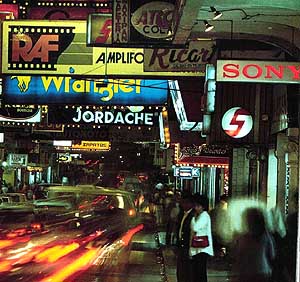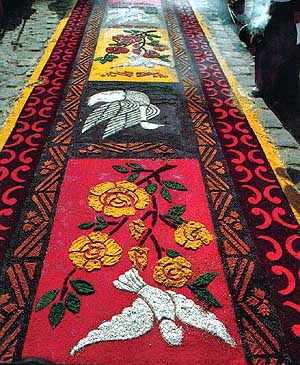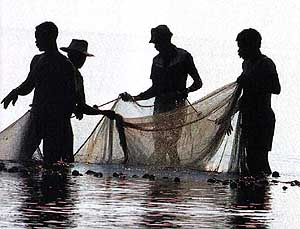by Chalerm Raksanti
Temperate highlands, tropical lowlands which front two
coasts, and the flat, jungles of the Peten region give geographic variety
to this unsettled and most populous nation of Central America. Pop culture
from North American USA and Canada reaches only the surface of
Guatemala’s complex and divided society. Separated by race and history,
and Indian majority and a largely Spanish ruling minority have given rise
to a Latino culture that accounts for about 45% of the population. Deep
rifts between rich and poor also impede a national identity.
 Flashy
and cosmopolitan Guatemala City
Flashy
and cosmopolitan Guatemala City
Where land is life, highlanders turn mountainsides into
terraced fields. Subdivided over centuries, small highland plots sustain
the country’s greatest rural population density. In a nation where a
wealthy handful owns half the farm acreage, land reform has been a major
fuse for national turmoil. It is true that Guatemala has climbed some dark
and steep stairs toward a fragile democracy, but to those who know it
best, the nation may be at last emerging into the light.
A claim to Belize was omitted from the 1985
constitution, which cooled a long-simmering dispute that pitted Guatemala
against world opinion, and Belize’s protector, Great Britain. Regionally
strategic as Mexico’s southern neighbor, Guatemala had been convulsed by
the longest running insurgency in Central America. But now the Guatemalans
feel that the biggest change in their country has been the ‘relaxing of
terror” on all sides.
Almost one third of the people in Central America live
in Guatemala. It is blessed with remarkably fertile volcanic soil, a
cosmopolitan middle class, and the largest manufacturing base in that tiny
isthmus which connects the two great continents of North and South
America. Yet is has never lived up to its potential. Consider education;
nearly half of the population is illiterate or semi-literate. Only 20
percent have gone to high school. Or consider health. The nation grows
enough good to export meat and vegetables to the USA and other Central
American countries. Yet of every hundred nationals who die, about 40 are
children under the age of five who perish from malnutrition. Distribution
of wealth is another sore point. The population is growing rapidly and
each decade there are twice as many citizens as there are new Guatemalan
jobs. Wealthy landowners control the country’s wealth, therefore the
politics.
 Fragile
designs of sawdust and flower petals line the streets of the villages
during the Good Friday celebrations
Fragile
designs of sawdust and flower petals line the streets of the villages
during the Good Friday celebrations
But the nation’s capital, Guatemala City enjoys an
affluent intimacy once reserved for the elite. An oasis of light and
cosmopolitan polish, Sixth Avenue’s commercial artery gleams at rush
hour in the heart of the largest urban population between Mexico City and
Medellin, Columbia. In this tiny country there is diversity. Though its
language of rule and its dominate culture are Hispanic, it is the only
state in North America with a predominately Indian population. It’s
prevailing Roman Catholicism, rich in history and moving ritual, is being
challenged by a lively Protestant movement that now claims the adherence
of about 30 percent of the population. Guatemala City is a modern Third
World capital 20 times larger than any provincial city in the country. And
the countryside is decades, some would say centuries, behind.
Even the geography does not seem to be of all one
piece. Climatically and topographically, it seems to be three countries.
The humid tropical lowlands of the Pacific littoral, the Atlantic coast
and the chilled and clouded highlands and volcano-dotted Sierra Madre are
tributes to a congenial region of variety of vegetation and climate.
Around the capital city something is always blooming. In January, the
flaming yellow palo blanco tree, in February, the sumptuous
bougainvillea, in March, the purple Nazarene, and so on through all
the seasons.
 The
diverse population includes the ‘black Caribe’ fishermen along the
Caribbean shores
The
diverse population includes the ‘black Caribe’ fishermen along the
Caribbean shores
Underneath this riot of color, the city has grown
uncontrolled, without plan. With or without jobs, Guatemalans move to the
city seeking a better life. Some find it, others are simply escaping rural
poverty and hoping for the best.
During Holy Week, Guatemalan religion expression
reaches its highest intensity. Shops close, traffic vanishes, and
Guatemala City is practically deserted. Elaborate costume processions
grace the streets of cities and villages. Heavy floats depicting the
Virgin Mary, the suffering Christ and other saintly figures pass slowly by
on the shoulders of villagers. Overnight these streets have been laid with
colored sawdust carpets. Some of them four blocks long. The crowd kneels
to pray as the procession reaches each station of the Cross, and the
dreamlike magic of Guatemala’s traditional life comes into full play.

 Flashy
and cosmopolitan Guatemala City
Flashy
and cosmopolitan Guatemala City Fragile
designs of sawdust and flower petals line the streets of the villages
during the Good Friday celebrations
Fragile
designs of sawdust and flower petals line the streets of the villages
during the Good Friday celebrations The
diverse population includes the ‘black Caribe’ fishermen along the
Caribbean shores
The
diverse population includes the ‘black Caribe’ fishermen along the
Caribbean shores